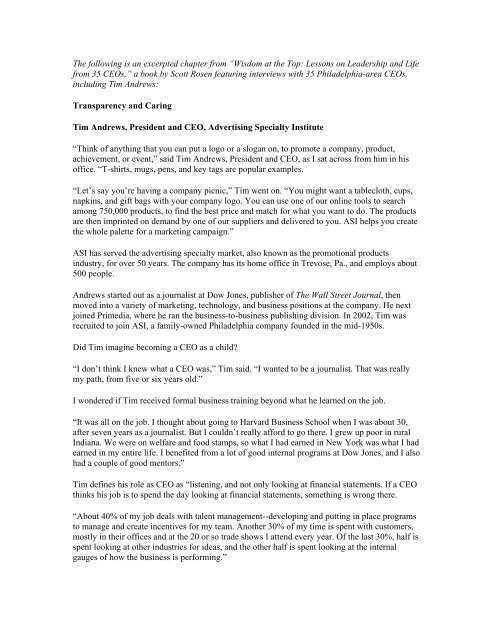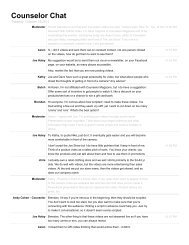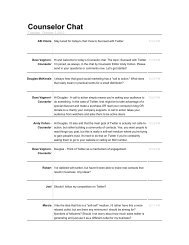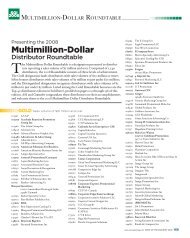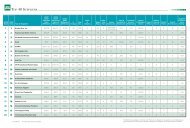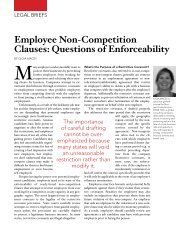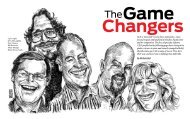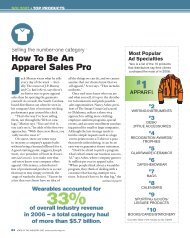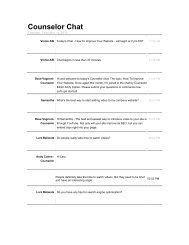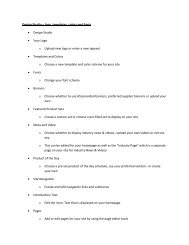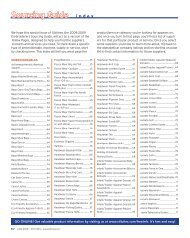The following is an excerpted chapter from “Wisdom at the Top ...
The following is an excerpted chapter from “Wisdom at the Top ...
The following is an excerpted chapter from “Wisdom at the Top ...
Create successful ePaper yourself
Turn your PDF publications into a flip-book with our unique Google optimized e-Paper software.
<strong>The</strong> <strong>following</strong> <strong>is</strong> <strong>an</strong> <strong>excerpted</strong> <strong>chapter</strong> <strong>from</strong> “W<strong>is</strong>dom <strong>at</strong> <strong>the</strong> <strong>Top</strong>: Lessons on Leadership <strong>an</strong>d Life<br />
<strong>from</strong> 35 CEOs,” a book by Scott Rosen fe<strong>at</strong>uring interviews with 35 Philadelphia-area CEOs,<br />
including Tim Andrews:<br />
Tr<strong>an</strong>sparency <strong>an</strong>d Caring<br />
Tim Andrews, President <strong>an</strong>d CEO, Advert<strong>is</strong>ing Specialty Institute<br />
“Think of <strong>an</strong>ything th<strong>at</strong> you c<strong>an</strong> put a logo or a slog<strong>an</strong> on, to promote a comp<strong>an</strong>y, product,<br />
achievement, or event,” said Tim Andrews, President <strong>an</strong>d CEO, as I s<strong>at</strong> across <strong>from</strong> him in h<strong>is</strong><br />
office. “T-shirts, mugs, pens, <strong>an</strong>d key tags are popular examples.<br />
“Let’s say you’re having a comp<strong>an</strong>y picnic,” Tim went on. “You might w<strong>an</strong>t a tablecloth, cups,<br />
napkins, <strong>an</strong>d gift bags with your comp<strong>an</strong>y logo. You c<strong>an</strong> use one of our online tools to search<br />
among 750,000 products, to find <strong>the</strong> best price <strong>an</strong>d m<strong>at</strong>ch for wh<strong>at</strong> you w<strong>an</strong>t to do. <strong>The</strong> products<br />
are <strong>the</strong>n imprinted on dem<strong>an</strong>d by one of our suppliers <strong>an</strong>d delivered to you. ASI helps you cre<strong>at</strong>e<br />
<strong>the</strong> whole palette for a marketing campaign.”<br />
ASI has served <strong>the</strong> advert<strong>is</strong>ing specialty market, also known as <strong>the</strong> promotional products<br />
industry, for over 50 years. <strong>The</strong> comp<strong>an</strong>y has its home office in Trevose, Pa., <strong>an</strong>d employs about<br />
500 people.<br />
Andrews started out as a journal<strong>is</strong>t <strong>at</strong> Dow Jones, publ<strong>is</strong>her of <strong>The</strong> Wall Street Journal, <strong>the</strong>n<br />
moved into a variety of marketing, technology, <strong>an</strong>d business positions <strong>at</strong> <strong>the</strong> comp<strong>an</strong>y. He next<br />
joined Primedia, where he r<strong>an</strong> <strong>the</strong> business-to-business publ<strong>is</strong>hing div<strong>is</strong>ion. In 2002, Tim was<br />
recruited to join ASI, a family-owned Philadelphia comp<strong>an</strong>y founded in <strong>the</strong> mid-1950s.<br />
Did Tim imagine becoming a CEO as a child?<br />
“I don’t think I knew wh<strong>at</strong> a CEO was,” Tim said. “I w<strong>an</strong>ted to be a journal<strong>is</strong>t. Th<strong>at</strong> was really<br />
my p<strong>at</strong>h, <strong>from</strong> five or six years old.”<br />
I wondered if Tim received formal business training beyond wh<strong>at</strong> he learned on <strong>the</strong> job.<br />
“It was all on <strong>the</strong> job. I thought about going to Harvard Business School when I was about 30,<br />
after seven years as a journal<strong>is</strong>t. But I couldn’t really afford to go <strong>the</strong>re. I grew up poor in rural<br />
Indi<strong>an</strong>a. We were on welfare <strong>an</strong>d food stamps, so wh<strong>at</strong> I had earned in New York was wh<strong>at</strong> I had<br />
earned in my entire life. I benefited <strong>from</strong> a lot of good internal programs <strong>at</strong> Dow Jones, <strong>an</strong>d I also<br />
had a couple of good mentors.”<br />
Tim defines h<strong>is</strong> role as CEO as “l<strong>is</strong>tening, <strong>an</strong>d not only looking <strong>at</strong> fin<strong>an</strong>cial st<strong>at</strong>ements. If a CEO<br />
thinks h<strong>is</strong> job <strong>is</strong> to spend <strong>the</strong> day looking <strong>at</strong> fin<strong>an</strong>cial st<strong>at</strong>ements, something <strong>is</strong> wrong <strong>the</strong>re.<br />
“About 40% of my job deals with talent m<strong>an</strong>agement--developing <strong>an</strong>d putting in place programs<br />
to m<strong>an</strong>age <strong>an</strong>d cre<strong>at</strong>e incentives for my team. Ano<strong>the</strong>r 30% of my time <strong>is</strong> spent with customers,<br />
mostly in <strong>the</strong>ir offices <strong>an</strong>d <strong>at</strong> <strong>the</strong> 20 or so trade shows I <strong>at</strong>tend every year. Of <strong>the</strong> last 30%, half <strong>is</strong><br />
spent looking <strong>at</strong> o<strong>the</strong>r industries for ideas, <strong>an</strong>d <strong>the</strong> o<strong>the</strong>r half <strong>is</strong> spent looking <strong>at</strong> <strong>the</strong> internal<br />
gauges of how <strong>the</strong> business <strong>is</strong> performing.”
I asked Tim how he dealt with <strong>the</strong> clim<strong>at</strong>e of fear <strong>an</strong>d uncertainty caused by <strong>the</strong> current recession.<br />
“<strong>The</strong> challenge <strong>is</strong> to keep your employees focused, grounded in truth <strong>an</strong>d not in fear. Wh<strong>at</strong> we<br />
have now <strong>is</strong> a n<strong>at</strong>ion grounded in fear <strong>an</strong>d not focused on <strong>the</strong> future. If everyone’s afraid about<br />
wh<strong>at</strong>’s going to happen, <strong>the</strong>n it’s going to happen. Yes, <strong>the</strong>re are a lot of people without jobs, but<br />
<strong>at</strong> <strong>the</strong> end of <strong>the</strong> day 92% of people do have jobs. In a downturn, people are still spending money<br />
<strong>an</strong>d you have to find out how to get th<strong>at</strong> business.”<br />
Throughout our interview, Tim emphasized h<strong>is</strong> role in fostering a corpor<strong>at</strong>e culture based on<br />
openness <strong>an</strong>d tr<strong>an</strong>sparency.<br />
“Wh<strong>at</strong> works for me <strong>is</strong> a quarterly all-comp<strong>an</strong>y meeting, where I spend about 45 minutes talking<br />
through <strong>the</strong> major highlights of <strong>the</strong> last quarter, but also focusing on wh<strong>at</strong>’s going to happen in<br />
<strong>the</strong> next few months,” Tim said. “<strong>The</strong>n I take questions. I think we average 15 questions, which<br />
may not sound like th<strong>at</strong> m<strong>an</strong>y, but <strong>the</strong>y’re pretty tough <strong>an</strong>d educ<strong>at</strong>ed questions. For example: ‘Six<br />
months ago you told us we were really going to work on market share. How are we doing?’ When<br />
you get a question like th<strong>at</strong> in front of 450 employees, you know people are l<strong>is</strong>tening.<br />
“When I joined <strong>the</strong> comp<strong>an</strong>y six years ago,” Tim recalled, “I told Norm<strong>an</strong> Cohn, <strong>the</strong> owner, after<br />
he interviewed me, th<strong>at</strong> I was going to say something to <strong>the</strong> employees <strong>an</strong>d <strong>the</strong>n take questions. I<br />
said I w<strong>an</strong>ted to set <strong>the</strong> tone for <strong>an</strong> open-door policy.<br />
“And Norm<strong>an</strong> said, ‘<strong>The</strong>y don’t ask questions <strong>at</strong> meetings.’<br />
“And I said, ‘<strong>The</strong>y will, because I’m not going to leave until I get three.’ And th<strong>at</strong>’s wh<strong>at</strong><br />
happened. People weren’t afraid to ask.<br />
“You’ll notice three windows in my office. It was a solid wall when I came here. On <strong>the</strong> first day<br />
I asked <strong>the</strong> building staff how long it would take to put in windows. People c<strong>an</strong> know inst<strong>an</strong>tly<br />
when I’m here <strong>an</strong>d when I’m not, just by looking in.<br />
“If people have <strong>the</strong> sense over time th<strong>at</strong> you’re tr<strong>an</strong>sparent <strong>an</strong>d telling it like it <strong>is</strong>,” Tim continued,<br />
“you’ve built a trust level where you c<strong>an</strong> be honest with <strong>the</strong>m, especially when bad times happen<br />
or you have to make a tough dec<strong>is</strong>ion. If you c<strong>an</strong> be honest with <strong>the</strong>m about <strong>the</strong> little things <strong>an</strong>d<br />
<strong>the</strong> good stuff, <strong>the</strong>y’ll know you’re serious when <strong>the</strong>re are also bad things to say.”<br />
Communic<strong>at</strong>ion in <strong>an</strong>y successful comp<strong>an</strong>y <strong>is</strong> a two-way street. When I asked Tim wh<strong>at</strong> sets him<br />
off, he said, “Finding out bad news after <strong>the</strong> fact, when someone knew it in adv<strong>an</strong>ce, or had a<br />
reasonable expect<strong>at</strong>ion it would happen. Number one, no CEO likes to be surpr<strong>is</strong>ed. Number two,<br />
if I had known about <strong>the</strong> problem in adv<strong>an</strong>ce, I could have avoided or limited <strong>the</strong> bad outcome, or<br />
made a different dec<strong>is</strong>ion.”<br />
Sometimes a family business c<strong>an</strong> be reluct<strong>an</strong>t to turn over <strong>the</strong> reins to <strong>an</strong> outsider. Th<strong>is</strong> wasn’t <strong>the</strong><br />
case <strong>at</strong> ASI.<br />
“Norm<strong>an</strong> <strong>an</strong>d h<strong>is</strong> family said I would make every business dec<strong>is</strong>ion. Th<strong>at</strong> doesn’t me<strong>an</strong> th<strong>at</strong> I<br />
don’t ask for advice <strong>an</strong>d th<strong>at</strong> it’s not widely supplied. Everyone has different viewpoints, <strong>an</strong>d I<br />
consider <strong>the</strong>m as I decide on <strong>the</strong> best course of action. Never have I been told by <strong>the</strong> family th<strong>at</strong> I<br />
couldn’t do something, even if o<strong>the</strong>r people didn’t agree.”
ASI has grown impressively since Andrews came on board six years ago. <strong>The</strong> comp<strong>an</strong>y has<br />
increased its d<strong>is</strong>tributor members <strong>from</strong> 17,000 to 23,000, while growing <strong>the</strong> supplier network to<br />
3,600. Its online marketing system, ESP Online, now has 33,000 users, up <strong>from</strong> 5,000 a few years<br />
ago.<br />
“I think we have a gre<strong>at</strong> opportunity to grow <strong>the</strong> number of d<strong>is</strong>tributors, to perhaps 40,000, in five<br />
to eight years. We’ve moved into C<strong>an</strong>ada in <strong>the</strong> last two years. It’s a signific<strong>an</strong>t market, <strong>an</strong>d we<br />
have o<strong>the</strong>r opportunities around <strong>the</strong> world.”<br />
I asked Tim how he views h<strong>is</strong> legacy.<br />
“I think a legacy <strong>is</strong> cre<strong>at</strong>ed by a series of actions, <strong>an</strong>d only becomes clear after <strong>the</strong> CEO <strong>is</strong> no<br />
longer around. I try to help people be <strong>the</strong> best <strong>the</strong>y c<strong>an</strong> be. I’m not sure th<strong>at</strong>’s a legacy, it’s more a<br />
style. If I c<strong>an</strong> do th<strong>at</strong>, I’ll feel really good.<br />
“I don’t look <strong>at</strong> th<strong>is</strong> as a collection of 500 employees, but as 500 families th<strong>at</strong> are depending on<br />
our dec<strong>is</strong>ion-making,” he went on. “Right now I’m going through wh<strong>at</strong> every CEO goes through,<br />
<strong>an</strong>d th<strong>at</strong>’s <strong>the</strong> renewal of our health insur<strong>an</strong>ce. It’s probably one of <strong>the</strong> largest costs th<strong>at</strong><br />
employers look <strong>at</strong>. <strong>The</strong>re are salaries, payroll taxes, <strong>an</strong>d <strong>the</strong>n healthcare. How do we fairly<br />
m<strong>an</strong>age th<strong>at</strong> increase?<br />
“We had five healthcare scenarios to choose among th<strong>is</strong> year, <strong>an</strong>d we immedi<strong>at</strong>ely elimin<strong>at</strong>ed<br />
three because I couldn’t st<strong>an</strong>d in front of my employees <strong>at</strong> <strong>an</strong> all-comp<strong>an</strong>y meeting <strong>an</strong>d feel<br />
comfortable explaining those options, given <strong>the</strong> culture we w<strong>an</strong>t to continue to have.”<br />
When I asked Tim wh<strong>at</strong> he was most proud of, he brought it back to ASI’s culture.<br />
“When I joined <strong>the</strong> comp<strong>an</strong>y, one of <strong>the</strong> siblings said, “You’re working for a family business.<br />
Wh<strong>at</strong> does th<strong>at</strong> me<strong>an</strong> to you?’<br />
“I gave a stumbling <strong>an</strong>swer because I had never been CEO of a family business. Two years<br />
passed before I was finally able to <strong>an</strong>swer <strong>the</strong> question: we care. We may not always be able to<br />
keep every employee <strong>an</strong>d we don’t toler<strong>at</strong>e underperform<strong>an</strong>ce. However, we make dec<strong>is</strong>ions <strong>from</strong><br />
a caring perspective, <strong>an</strong>d th<strong>at</strong>’s good.<br />
“I think it’s really import<strong>an</strong>t to give back. You c<strong>an</strong> run <strong>an</strong> org<strong>an</strong>iz<strong>at</strong>ion with a heads-down,<br />
bottom line approach. Or you c<strong>an</strong> take <strong>the</strong> heads-up approach, which <strong>is</strong> wh<strong>at</strong> <strong>the</strong> Cohn family<br />
does. We’ve done a tremendous amount to get <strong>the</strong> comp<strong>an</strong>y involved in charitable work. Every<br />
holiday season we have <strong>an</strong> adopt-a-family program through <strong>the</strong> local homeless shelter <strong>at</strong> <strong>the</strong><br />
Americ<strong>an</strong> Red Cross. We ask employees to volunteer, <strong>an</strong>d <strong>the</strong>y buy toys <strong>an</strong>d clothing for children<br />
<strong>an</strong>d families with <strong>the</strong>ir own money. Last year about 80% of <strong>the</strong> employees volunteered for <strong>the</strong><br />
program. We helped about 60 or 70 kids have a gre<strong>at</strong> holiday season.<br />
“And we give out a free turkey to every employee during <strong>the</strong> holidays,” Tim added. “When we<br />
did a survey of employees, 93% said don’t mess with <strong>the</strong> turkey. So <strong>the</strong> turkey <strong>is</strong> safe.”


